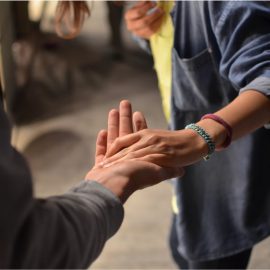

This article is an excerpt from the Shortform book guide to "The Like Switch" by Jack Schafer and Marvin Karlins. Shortform has the world's best summaries and analyses of books you should be reading.
Like this article? Sign up for a free trial here.
What are examples of bad nonverbal communication? What is the effect of negative body language?
It’s easy to tell how a person is feeling through their body language. When you roll your eyes or avoid eye contact with people, they might take it as an insult.
Below we’ll look at examples of bad nonverbal communication that Jack Schafer and Marvin Karlins highlight in their book The Like Switch.
Negative Body Language
The authors advise that we often display these bad nonverbal communication cues without knowing it, even when we want to make friends. Learning what they are can therefore help you recognize if you’re unconsciously pushing people away, as well as helping you spot when others aren’t interested in being friends with you.
1. Staring Excessively and Looking Someone Up and Down
Both of these actions are perceived as aggressive and invasive, signaling to the other person that you pose a threat.
(Shortform note: If you often find yourself a victim of unwanted stares, there are a few actions you can take to stop the other person in their tracks. First, make eye contact and stare back until they notice. Often, if someone is looking at you out of curiosity, they’ll smile and look away, embarrassed that they were caught. If they continue staring, raise your eyebrow and frown to let them know you don’t appreciate it. Finally, if necessary, let them know verbally that they’re making you uncomfortable, or remove yourself from the situation.)
2. Rolling Your Eyes
This signals contempt and disapproval toward a person’s words or actions. If you’re talking to someone and they roll their eyes, they disagree with what you have to say.
(Shortform note: Schafer and Karlins bring up eye-rolling in the context of interactions between adults. However, the most infamous type of eye roll is the teenage eye roll. Why do so many teens turn to this unproductive mode of communication? Like their adult counterparts, teenagers roll their eyes to signal disagreement and frustration toward their target. Eye-rolling is a way for them to dismiss the possibility of further discussion. Teenagers use this nonverbal cue so frequently because they’re going through a tumultuous period of developmental change. These changes leave them hypersensitive to criticism and anger, leading them to shut down in moments of conflict.)
3. Tension in Your Face
If you display a tight jaw, a furrowed brow, and narrowed eyes, you’re communicating threatening messages. Often, we’re just tense about the stressors of our daily lives, but potential friends can easily misinterpret that as unfriendliness.
(Shortform note: No matter how hard you try to appear friendly, sometimes the stress of life will catch up with you and cause muscle tension, including in your facial muscles. When this happens, appearing unfriendly should be the least of your worries—tension in the face can also cause frequent headaches and discomfort. There are many techniques you can use when you need to relax those muscles and let go of the day’s worries. For example, try stretching your mouth into a wide smile, counting to five, then relaxing your facial muscles. Repeat this 10 times for the best results.)
4. Crossing Your Arms
This is a protective gesture that places a barrier between you and the other person. It signals anxiety and discomfort.
(Shortform note: Before you assume the negative meaning of someone’s crossed arms, consider the context of the situation: The gesture can also have meanings that are much more benign. People might cross their arms because they need a comfortable resting place for them, or because it’s cold outside and the arms bring extra warmth to the body’s core. Many people also cross their arms when they’re concentrating hard or critiquing something.)
5. Invading Personal Space
We all desire a certain amount of empty space around us, and we want other people to respect this space. If people invade our boundaries, we perceive them as a threat. For example, imagine you’re standing on a nearly empty train platform, and another passenger approaches. Instead of standing a respectful distance away, they choose to stand right next to you, even though there’s plenty of space to spread out. This will most likely make you feel irritated and uncomfortable because your personal space has been violated.

———End of Preview———
Like what you just read? Read the rest of the world's best book summary and analysis of Jack Schafer and Marvin Karlins's "The Like Switch" at Shortform.
Here's what you'll find in our full The Like Switch summary:
- How to cultivate the qualities you need to attract and connect with new friends
- How to have meaningful, smooth conversations with friends
- How you can productively manage conflict in relationships






